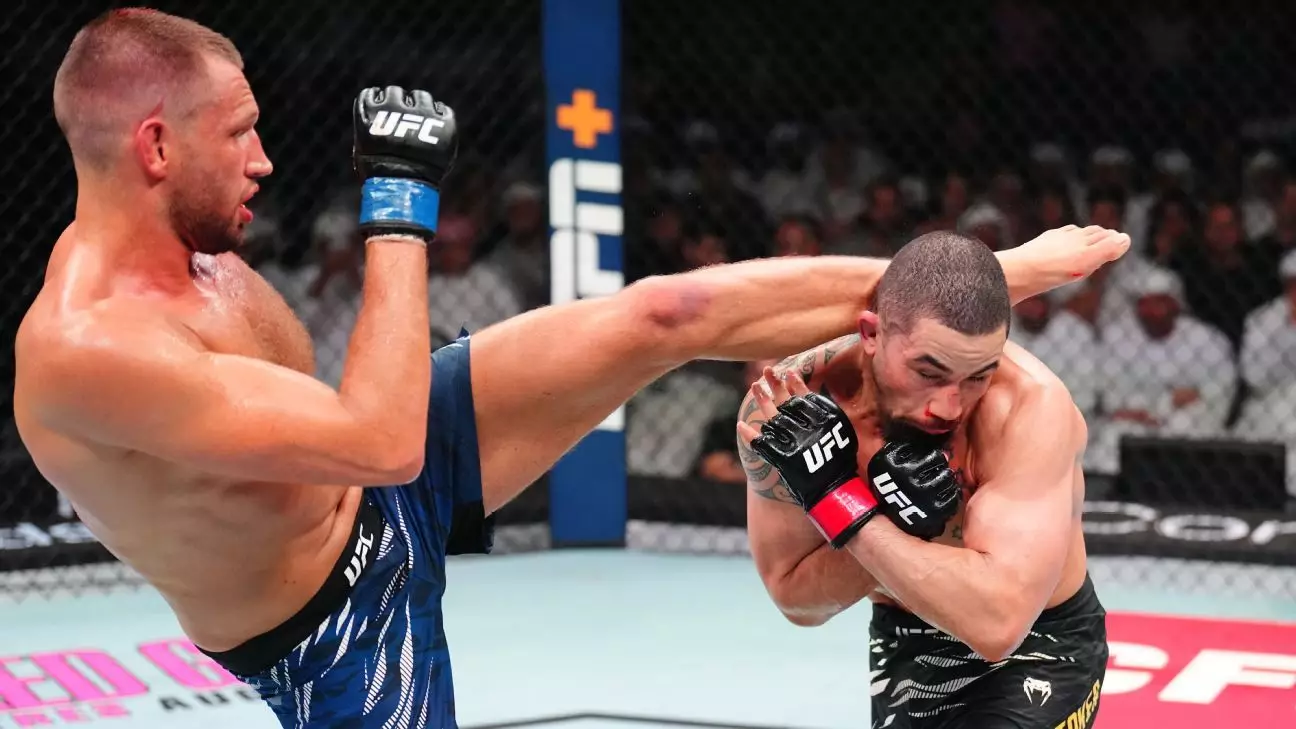Reinier de Ridder’s recent triumph over Robert Whittaker isn’t just another highlight in his career—it marks a pivotal moment that could reshape perceptions about his potential at the top of the UFC’s middleweight division. While fans and analysts have long recognized his grappling prowess, de Ridder’s impressive display of pressure, volume striking, and resilience elevates his status from promising contender to an emerging force capable of challenging current kings. This victory, earned via split decision, underscores a growing narrative: value isn’t solely in stats or flashy finishes but also in relentless determination and adaptability under pressure.
De Ridder’s ability to control the fight’s tempo, despite Whittaker’s resistance, signals a tactical maturity that surpasses mere ground game. With nearly nine minutes of control and a significant volume of punches—more than 160 strikes—de Ridder demonstrated a willingness to impose his style on an esteemed opponent. His commitment to the takedown game, even against a skilled defender like Whittaker, showcased strategic patience and tactical versatility. This wasn’t about relying only on submissions but about dictating pace and draining the best of his opponent’s durability.
The Power of Pressure and Volume in Modern MMA
What sets de Ridder apart is his aggressive approach fused with relentless volume—an increasingly vital trait in MMA’s evolving landscape. His volume striking wasn’t just a tactic to amass points but a means to wear down a resilient opponent like Whittaker. The Australian’s best moment—clocked with a clean counter right hand—highlighted Whittaker’s capability to catch de Ridder off guard. Nonetheless, de Ridder’s resilience and refusal to capitulate kept him in the fight, ultimately earning him the victory that might propel him into title contention.
The striking discrepancy, with a considerable edge in landed strikes and control time, paints a picture of a fighter who is ready to challenge champions. Despite close judging, the overwhelming statistical lead suggests de Ridder’s fighting style is not dependent on luck or judicious judges’ scoring but on tangible, effective aggression. His willingness to mix up his approach—alternating striking with takedowns—demonstrates strategic adaptability. It reveals a fighter who recognizes that modern MMA favors sustained volume and pressure, traits he showcased superbly against a seasoned veteran.
Grappling as a Foundation, but Pressure as a Weapon
De Ridder’s reputation as a submission specialist—having 14 finishes via tapout—often leads critics to underestimate his striking acumen. Yet, his performance against Whittaker proves that his true strength lies not only in choking opponents out but also in dictating fights with his pace and relentless forward pressure. Whittaker’s impressive defensive work, particularly in defending 13 of 15 takedown attempts, further emphasizes that de Ridder’s success wasn’t solely based on grappling but on an ability to impose his will.
This fight exemplifies how modern MMA fighters must evolve beyond specialization. De Ridder’s capacity to adapt—transitioning seamlessly from grappling threats to high-volume striking—reflects a nuanced understanding of fight dynamics. His desire to avoid future lengthy battles against tough veterans such as Whittaker indicates a hunger to secure finishes early, a mindset that could serve him well in future high-stakes bouts.
The Road Forward: A Challenger’s Ambition with a Bold Edge
Seizing the moment, de Ridder called out title contender Khamzat Chimaev or Dricus Du Plessis, signaling his ambition to rapidly ascend the ranks. While he currently sits at No. 13, his recent performances have demonstrated that rankings are merely numbers—what truly matters is his willingness to take risks and his strategic growth. His willingness to confront top-tier opponents demonstrates confidence; it also suggests he’s aware that only by facing the best can he truly gauge his progress and refine his skills.
For Robert Whittaker, this loss indicates a phase of reflection. Having not suffered back-to-back defeats since 2013, his resilience remains undoubted, but the importance of adjusting his style before facing elite competition again is clear. As for de Ridder, the victory isn’t just a feather in his cap but a declaration: he’s here to carve out a definitive place among middleweight elites. His win is a testament to his evolution as a fighter and his refusal to accept mediocrity—a trait that will serve him well as he targets championship gold.
In this moment of rising stars and seasoned veterans, de Ridder’s triumph highlights that MMA is a sport where continuous adaptation, relentless pressure, and mental toughness often determine a fighter’s trajectory. Whether or not he achieves the title in the near future, this victory undeniably sets him apart as a fighter to watch—and possibly fear—in the division’s competitive hierarchy.

